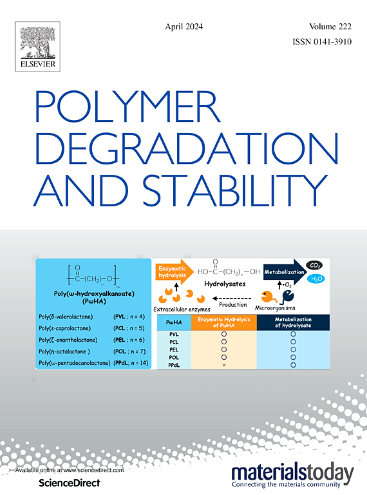聚酯聚氨酯的水解:通过傅立叶变换红外 2D-COS 光谱深入研究机理途径
IF 6.3
2区 化学
Q1 POLYMER SCIENCE
引用次数: 0
摘要
热塑性聚(酯聚氨酯)(PEU)的水解过程因其嵌段共聚物相结构和多个官能团相互竞争的水解敏感性而错综复杂。进水的确切途径、水与材料的相互作用以及最终官能团水解的动力学和顺序仍有待完善。需要更多的诊断方法来深入了解和分解材料的变化。结合 GPC 结果,对一种很有前景的分析技术--二维相关光谱(2D-COS)--进行了审查,并将其应用于分析在暴露时间、温度和相对湿度等各种条件下老化的水解聚乙烯醇的傅立叶变换红外光谱。2D-COS 可以确定水的复杂作用和不同的中间步骤,还能强调 PEU 在较易受官能团影响的水解初始阶段。作为原材料的一个复杂因素,ATR IR 在商用聚乙烯醇珠及其压制片材的表面检测到一些滑石粉,这些滑石粉会干扰水的进入,从而延缓聚乙烯醇的水解,尤其是在其天然形态或在较低温度(如低于聚乙烯醇熔点)下进行适度老化的情况下。当老化温度升高到熔点以上时,即使 PEU 内部残留的微量水也足以启动水解作用,然后随着温度的升高,水解作用会更加剧烈。2D-COS 分析的反馈信息证实,聚乙烯醇的水解始于软段中的酯类,然后才是氨基甲酸乙酯连接中的酯类。只有当 PEU 的分子量低于临界摩尔质量 (Mc)时,硬段中才会同时发生水解,因为此时不存在保护性形态相结构。目前的观察结果表明,在聚合物降解过程中,"未知 "添加剂可能会产生意想不到的行为,PEU 的时间性和特定基团水解是局部可用水分子的函数,易受影响的官能团的反应顺序,以及分子量变化与聚合物相结构耦合的重要性。本文章由计算机程序翻译,如有差异,请以英文原文为准。

Hydrolysis of poly(ester urethane): In-depth mechanistic pathways through FTIR 2D-COS spectroscopy
The hydrolysis of thermoplastic poly(ester urethane) (PEU) is convoluted by its block copolymer phase structure and competing hydrolytic sensitivities of multiple functional groups. The exact pathways for water ingress, water interaction with the material and ultimately the kinetics and order of functional group hydrolysis remain to be refined. Additional diagnostics are needed to enable deeper insight and deconvolution of material changes. In combination with GPC results, a promising analytical technique – two-dimensional correlation spectroscopy (2D-COS) – has been reviewed and applied to analyze FTIR spectra of hydrolyzed PEUs aged under various conditions, such as exposure time, temperature, and relative humidity. 2D-COS allows the complex role of water with distinct intermediate steps to be established, plus it emphasizes the initial stages of PEU hydrolysis at more susceptible functional groups. As a complication for the raw material, ATR IR detected some talc on the surface of commercial PEU beads and pressed sheets thereof, which can interfere with water ingress and thereby retards PEU hydrolysis, particularly in its natural form or moderate aging at lower temperatures (e.g., below the melting point of PEU). As aging temperature increases above the melting temperature, even traces of water trapped inside the PEU are sufficient to initiate the hydrolysis, which then progresses strongly with increasing temperatures. Feedback from 2D-COS analysis confirms that PEU hydrolysis starts at esters in the soft-segments before those in the urethane linkage become susceptible. Only when the molecular weight of PEU is below a critical molar mass (Mc) will the hydrolysis occur in parallel in the hard-segments since protective morphological phase structures are then absent. The current observations demonstrate unexpected behavior that may result from 'unknown' additives in polymer degradation, the temporal and group-specific hydrolysis of PEU as a function of locally available water molecules, the order of reactivity of susceptible functional groups, and the importance of changes in molecular weight coupled with the phase structure of the polymer.
求助全文
通过发布文献求助,成功后即可免费获取论文全文。
去求助
来源期刊

Polymer Degradation and Stability
化学-高分子科学
CiteScore
10.10
自引率
10.20%
发文量
325
审稿时长
23 days
期刊介绍:
Polymer Degradation and Stability deals with the degradation reactions and their control which are a major preoccupation of practitioners of the many and diverse aspects of modern polymer technology.
Deteriorative reactions occur during processing, when polymers are subjected to heat, oxygen and mechanical stress, and during the useful life of the materials when oxygen and sunlight are the most important degradative agencies. In more specialised applications, degradation may be induced by high energy radiation, ozone, atmospheric pollutants, mechanical stress, biological action, hydrolysis and many other influences. The mechanisms of these reactions and stabilisation processes must be understood if the technology and application of polymers are to continue to advance. The reporting of investigations of this kind is therefore a major function of this journal.
However there are also new developments in polymer technology in which degradation processes find positive applications. For example, photodegradable plastics are now available, the recycling of polymeric products will become increasingly important, degradation and combustion studies are involved in the definition of the fire hazards which are associated with polymeric materials and the microelectronics industry is vitally dependent upon polymer degradation in the manufacture of its circuitry. Polymer properties may also be improved by processes like curing and grafting, the chemistry of which can be closely related to that which causes physical deterioration in other circumstances.
 求助内容:
求助内容: 应助结果提醒方式:
应助结果提醒方式:


